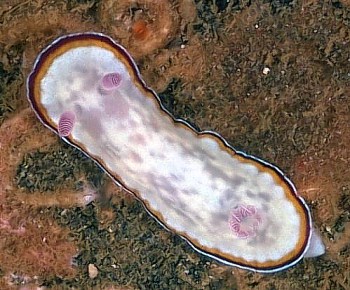
Chromodoris preciosa
(Kelaart, 1858)
Order: NUDIBRANCHIA
Suborder: DORIDINA
Superfamily: EUDORIDOIDEA
Family: Chromodorididae
DISTRIBUTION
Indo-West Pacific
PHOTO
UPPER RIGHT: Îlot Freycinet, Nouméa, 1m, 23 October 1988, NC083, AM C156678 New Caledonia
LOWER: A,Darwin, NT, June 1987, C153619. B, Koumac Beach (=Baie de Ouanap), near Koumac, New Caledonia, 20°34'S, 164°16'E, mixed soft and hard substrate, grassbeds, algae, October 1993, 2 specimens (10 & 27mm long alive), AM C200602. C, Lagoon between mainland and Récif de l'Infernet, off Koumac, New Caledonia, 20°34.4'S, 164°13'E, 12m, silty bottom with dense gorgonian beds, 18 October 1993, 2 specimens (15 & 18mm long alive), AM C200520.
This species was described by Kelaart (1858), from Ceylon. There are a number of chromodorid species which are essentially white with yellow and red bands at the mantle edge which, for ease of comparison, I have previously called the C. verrieri - colour group (Rudman, 1985). [When I have pages for the other species completed I will add a page comparing the species in the group]
C. preciosa has three colour bands at the mantle edge - a thin white band at the edge, then a band of deep red, and inside that, a band of yellow. The mantle ranges in background colour from a uniform white (A) to animals in which the white pigment forms irregular patches on a translucent white background (B). Sometimes the translucent patches can be distinctly reddish. Some specimens can also have small brownish spots scattered all over the central part of the mantle (C). In these spotted specimens the inner yellow band is often broken into a series of yellow streaks. In all cases the gills and rhinophore clubs are translucent red with pigmented white edging to the lamellae. This is common both intertidally and subtidally under rocks in New Caledonia.
Reference:
•Rudman, W.B. (1985) The Chromodorididae (Opisthobranchia: Mollusca) of the Indo-West Pacific: Chromodoris aureomarginata, C. verrieri and C. fidelis colour groups. Zoological Journal of the Linnean Society, 83: 241-299.
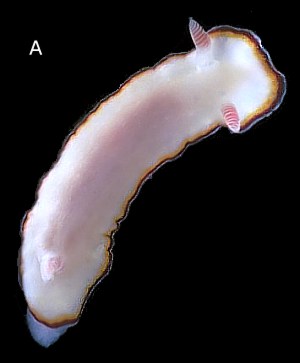
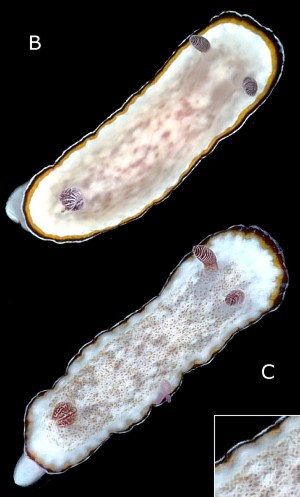
Rudman, W.B., 2000 (July 2) Chromodoris preciosa (Kelaart, 1858). [In] Sea Slug Forum. Australian Museum, Sydney. Available from http://www.seaslugforum.net/find/chroprec
Related messages
Chromodoris preciosa from Indonrsia
December 20, 2006
From: Erwin Kodiat

Hi Bill,
Read through some books but can't find a perfectly match ID with this photo. Can you help me ID this?
Locality: Lembeh Strait, 15 metres, North Sulawesi, Indonesia, Lembeh Strait, 20 October 2006, Sandy. Length: 1.5 cm. Photographer: Erwin Kodiat.
Erwin Kodiat
ungu@terong.com
Kodiat, E., 2006 (Dec 20) Chromodoris preciosa from Indonrsia. [Message in] Sea Slug Forum. Australian Museum, Sydney. Available from http://www.seaslugforum.net/find/18929Dear Erwin,
This is the spotted form of Chromodoris preciosa
Best wishes,
Bill Rudman
Chromodoris preciosa from Indonesia
June 10, 2005
From: Carl Scott
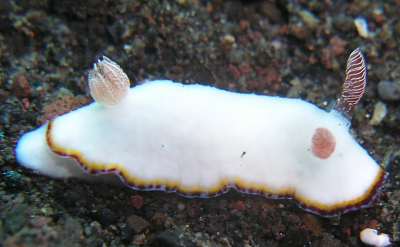
Got one for you here that I can't quite pin down. It has the mantle edge characteristics that are described for Chromodoris rufomaculata, but it is solid white inside the edges. Please assist!
Locality: Tulamben, Bali, Indonesia, Bali Sea (Laut Bali). Depth: 10-15 meters. Length: 3 cm. 26 May 2005. sandy slope. Photographer: Carl Scott
Carl Scott
carl@carlscott.net
Scott, C., 2005 (Jun 10) Chromodoris preciosa from Indonesia. [Message in] Sea Slug Forum. Australian Museum, Sydney. Available from http://www.seaslugforum.net/find/14008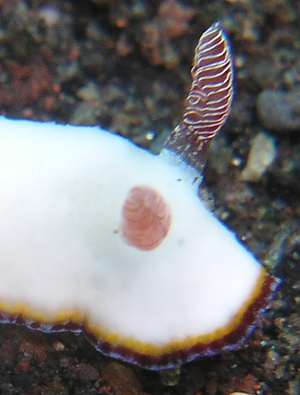
Dear Carl,
When identifying species from descriptions it's important to go for the general pattern as well as special details. I'm afraid some individuals some individuals vary from the norm. I guess without such variation we would not have evolution. Life would be very boring if everything was the same shade of grey!
In this case the row of red dots around the edge is usually a solid red line. It is C. preciosa, which has white, red and yellow colour bands around the mantle edge. The manrle is white, sometimes with fine reddish spots, and the gills and rhinophores are translucent red with white edging.
Best wishes,
Bill Rudman
Chromodoris preciosa from Malapascua, The Philippines
February 1, 2005
From: Paul Osmond
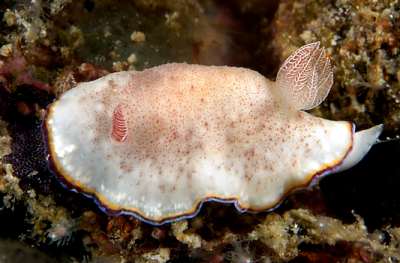
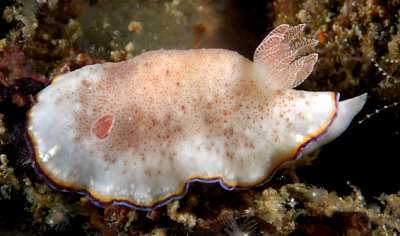
Bill,
Congrats on getting the forum moving again - hopefully you have the Museum's support now and it is not all your own personal time.
Anyway, onto the nudibranchs.
Found this single specimen of what I believe is Chromodoris trimarginata on a shallow dive just off the coast of Malapascua Island in Cebu, The Philippines. It was about 50mm long and the whole area is about 25 feet deep in basically a sandy ocean floor area.
Locality: Exotic Resort Shore Dive, Malapascua, Malapascua Island, The Philippines. Depth: 25 ft. Length: 50 mm. 3 December 2004. Shallow ocean floor, man made wreckage. Photographer: Paul Osmond
It was on a bunch of man-made wreckage that was placed in the area to form a shore dive - most of it being old cars, building frames, etc.
Yours,
Paul
marriard@deepseaimages.com
Osmond, P.T., 2005 (Feb 1) Chromodoris preciosa from Malapascua, The Philippines. [Message in] Sea Slug Forum. Australian Museum, Sydney. Available from http://www.seaslugforum.net/find/12849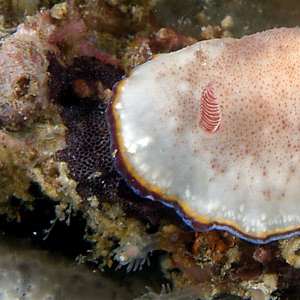
Dear Paul,
This certainly is within the C. trimarginata group of species, but I think it is best identified as Chromodoris preciosa. I suspect when know more about this group of species we may consider some of them to be variations of one species. When these species were described, the descriptions were based on one or two specimens from a single locality. Usually the colour information was based on a colour painting, or even a rough sketch with colour notes, so the subtleties we now know are important were never considered.
Another interesting feature of your photos [see close-up alomgside] is the purple sponge which I am pretty sure is the food of this species.
Best wishes,
Bill Rudman
Chromodoris preciosa from the Philippines
August 22, 2003
From: Erwin Köhler
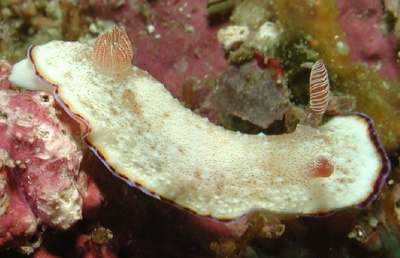
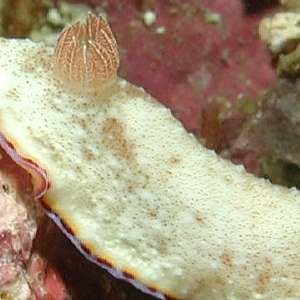
Dear Bill,
This one looks like Chromodoris verrieri, but it has a blue mantle border, then a brownish-red line, then an orange-yellow. It is from the Philippines, Malapascua island, divesite "Gato Cave".
data:
length 33mm
depth 19m
date 24 Feb. 2003
Regards,
Erwin
www.Philippine-Sea-Slugs.com
Erwin@Philippine-Sea-Slugs.com
Koehler, E., 2003 (Aug 22) Chromodoris preciosa from the Philippines. [Message in] Sea Slug Forum. Australian Museum, Sydney. Available from http://www.seaslugforum.net/find/10735Dear Erwin,
This is the similarly coloured species, Chromodoris preciosa.
Best wishes,
Bill Rudman
Chromodoris preciosa from Papua New Guinea
September 30, 2001
From: Marli Wakeling
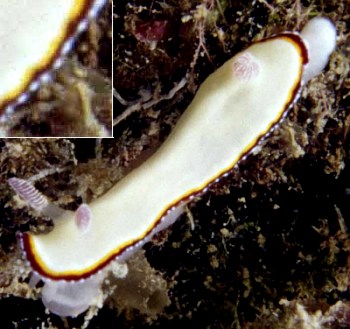
Here is what I think is Chromodoris preciosa. It was found crawling on an old piece of wood at a dive site known as 'The Slipway'.
Date: August 2001
Location: Kavieng, Papua New Guinea
Depth: 5 metres
Length: 2.5 cm.
Marli
scubamarli@excite.com
Wakeling, M., 2001 (Sep 30) Chromodoris preciosa from Papua New Guinea. [Message in] Sea Slug Forum. Australian Museum, Sydney. Available from http://www.seaslugforum.net/find/5321Thanks Marli,
This is an interesting photo showing the outermost mantle band to consist of a series of opaque white 'glands' or 'sacs', and lacking the normal opaque white pigmentation.
Best wishes,
Bill Rudman
Chromodoris preciosa from Tonga
May 3, 2001
From: Don Barclay
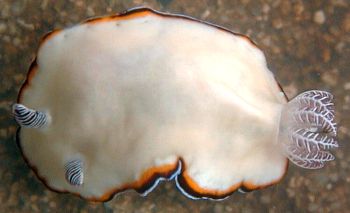
Hi again, Bill,
Here's the other nudibranch from Tonga that I've had trouble identifying. It is so distinctive that I figured I would have no problem finding it, but perhaps I've simply overlooked it. The white, black, and orange marginal bands, along with the lavender markings on the rhinophores and gills should make it a cinch. Did I overlook it on the Forum?
This one was about 20mm long, and was collected on a cream-colored sponge under a slab in shallow water (~1m deep) in front of the Tongan Beach Resort, Utungake Island, Vava'u, Tonga. It was found on the afternoon of 15 February 2001.
Thanks for all the great work you do with the Sea Slug Forum.
Cheers,
Don
n5ols@samoatelco.com
Barclay, D., 2001 (May 3) Chromodoris preciosa from Tonga. [Message in] Sea Slug Forum. Australian Museum, Sydney. Available from http://www.seaslugforum.net/find/4259Dear Don,
This is Chromodoris preciosa which in larger animals develops this uniform opaque creamy white background colour. Yes this species was on the Forum, but I am more than happy to see this photo as anything from Tonga will be a new distribution record.
Best wishes,
Bill Rudman
Chromodoris preciosa from Solomon Ids
January 2, 2001
From: Bruce Potter
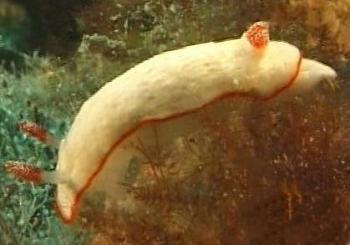
Bill,
I found a pair of these very small white nudibranchs, and a third single one about 20 feet away. This is just outside of Honiara in Solomon Islands. They were in about 8 meters, on algae covered coral rubble.
They were about 12mm long. The white surface was not smooth, but just a little bit bumpy.
I have not found it in any of my books. Do you know it?
Bruce Potter.
bruce.potter@adventist.org.sb
Potter, B., 2001 (Jan 2) Chromodoris preciosa from Solomon Ids. [Message in] Sea Slug Forum. Australian Museum, Sydney. Available from http://www.seaslugforum.net/find/3232Dear Bruce,
It looks like Chromodoris preciosa. The gills are retracted and it is a bit hard to distinguish the red and yellow mantle border, but on the whole I am pretty sure that's what it is.
Best wishes,
Bill Rudman.
Chromodoris daphne? from Papua New Guinea
September 4, 2000
From: Mary Jane Adams
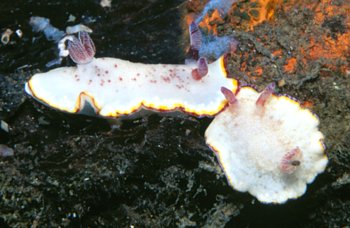
Hi Bill,
Here are some Chromodoris daphne I found on a silty sand slope near Alotau, Papua New Guinea.
Depth: 5 meters
Crawling length of larger one: 22 mm
May, 1998
The spots on the smaller slug are numerous tiny pinpoints. There some opaque white spots near the edge of the mantle that I am guessing are poison glands. There are three bands of color on the mantle edge; yellow, maroon and a thin discontinuous bluish purple which is more prominent around the head.
One of my other shots of these slugs shows the gills partially retracted. I just discovered that C. daphne is supposed to be endemic to NSW, so I guess that presents a problem.
Thanks so much for keeping up the Forum.
Best regards,
Mary Jane
mjadams@earthlink.net
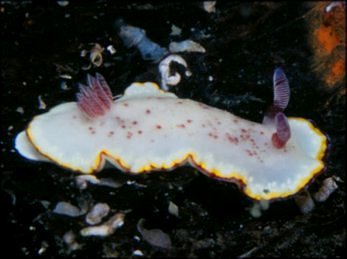
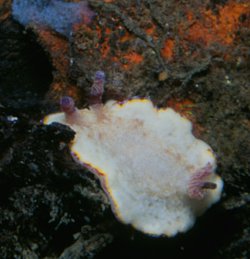
Dear Mary Jane,
This is an interesting find. I think it is Chromodoris preciosa. Chromodoris daphne seems to be restricted to south-eastern Australia, although Marshall & Willan (1999) record it from the southernmost end of the Great Barrier Reef. It does not have a white or clear band at the sdge of the mantle and no white edging to the gills or rhinophores. In your photos there is some trace of a whitish mantle border outside the red, and white edging to the gills and rhinophores. I have not seen distinct red spots, as in your photo, in Chromodoris preciosa but the mottled animal certainly is characteristic of that species.
It also has similarities to Chromodoris trimarginata but in that species the gills and rhinophores are white or colourless. Alternatively we have to begin thinking that some of these species are just colour forms of each other, but as I commented recently about Glossodoris cincta, sometimes, when internal anatomy doesn't help with clearcut differences, it is difficult to decide where one species ends and another begins.
Photos like yours, although they complicate the picture, are extremely welcome because what we really want is the actual picture, not the easy answer.
Best wishes,
Bill
Chromodoris preciosa from Vanuatu
July 5, 2000
From: Vinka Stenhouse
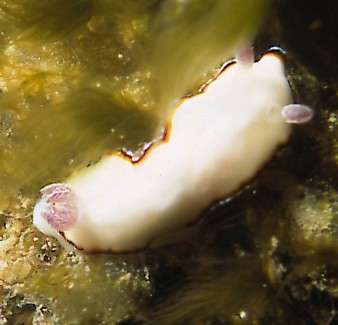
Dear Bill,
Here is another one from Espiritu Santo Is., Vanuatu. It was 15mm long.
Yours sincerely,
Vinka Stenhouse.
Santo.
Vanuatu.
Dear Vinka,
This is Chromodoris preciosa, one of a group of white chromodorids with red and yellow borders I am gradually preparing pages for the Forum.
Best wishes,
Bill Rudman.
